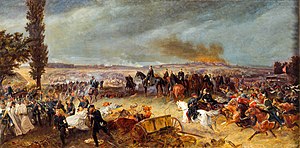
Back الحرب النمساوية البروسية Arabic Avstriya–Prussiya müharibəsi AZ اوتریش و پروس ساواشی AZB Deitscha Kriag BAR Аўстра-пруска-італьянская вайна BE Австрийско-пруско-италианска война Bulgarian Brezel etre Prusia hag Aostria BR Guerra Austroprussiana Catalan Prusko-rakouská válka Czech Den preussisk-østrigske krig Danish
| Austro-Prussian War | |||||||||
|---|---|---|---|---|---|---|---|---|---|
| Part of the wars of German unification and the Austria–Prussia rivalry | |||||||||
 Battle of Königgrätz, by Georg Bleibtreu. Oil on canvas, 1869 | |||||||||
| |||||||||
| Belligerents | |||||||||
|
Prussian-led German states
|
| ||||||||
| Commanders and leaders | |||||||||
| Strength | |||||||||
|
637,262[1] |
522,203[2]
| ||||||||
| Casualties and losses | |||||||||
|
Total: 132,414[2]
| |||||||||
The Austro-Prussian War (also known by many other names like the Seven Weeks' War, German Civil War, Brothers War or Fraternal War, known in Germany as Deutscher Krieg ("German War"), Deutscher Bruderkrieg (pronounced [ˌdɔʏtʃɐ ˈbʁuːdɐkʁiːk] (![]() listen); "German war of brothers")) was a war fought in 1866 between the Austrian Empire and the Kingdom of Prussia. Each side was helped by many allies in the German Confederation. Prussia had also allied with the Kingdom of Italy. This connected the conflict to the Third Independence War of Italian unification. The Austro-Prussian War was part of the rivalry between Austria and Prussia. It ended with Prussian control over the German states.
listen); "German war of brothers")) was a war fought in 1866 between the Austrian Empire and the Kingdom of Prussia. Each side was helped by many allies in the German Confederation. Prussia had also allied with the Kingdom of Italy. This connected the conflict to the Third Independence War of Italian unification. The Austro-Prussian War was part of the rivalry between Austria and Prussia. It ended with Prussian control over the German states.
The biggest result of the war was a change in power over the German states away from Austrian and towards Prussian hegemony. The German Confederation was ended and replaced by the North German Confederation. Italy also took the Austrian province of Venetia after the war.
The war started when Prussian troops invaded Schleswig-Holstein. The region had been disputed between Prussia and Austria ever since it was taken by them from Denmark. Prussia then invaded Hanover, Saxony, and the Electorate of Hesse on 15 June. Italy declared war on Austria on 20 June.
- ↑ Clodfelter 2017, p. 182.
- ↑ 2.0 2.1 Clodfelter 2017, p. 183.
- ↑ Clodfelter 2017, pp. 183–184.